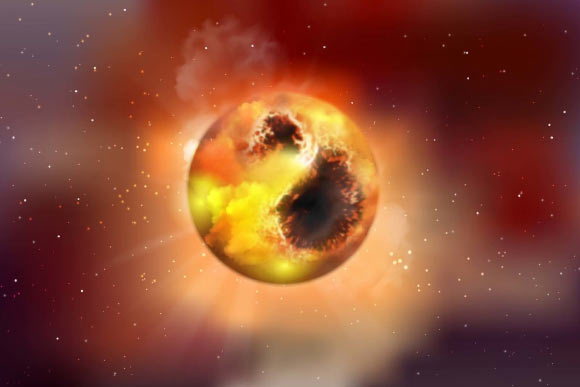A new paper published in the Astrophysical Journal Letters points to the changes in the photosphere of the red supergiant star Betelgeuse as the source of the recent unusual dimming.

An artist’s impression of the red supergiant star Betelgeuse. Image credit: Graphics Department, Max Planck Institute for Astronomy.
Betelgeuse, the second brightest star in the constellation Orion, is a red supergiant located approximately 650 light-years away from Earth.
With a radius around 1,400 times larger than the Sun’s, Betelgeuse is one of the biggest stars known. It is also one of the most luminous stars known, emitting more light than 100,000 Suns.
With an age of only 8 million years, Betelgeuse is already nearing the end of its life and is soon doomed to explode as a supernova.
But the star’s unusual dimming, which began in October 2019, wasn’t necessarily a sign of an imminent supernova.
“Towards the end of their lives, stars become red giants,” said Dr. Thavisha Dharmawardena, an astronomer at the Max Planck Institute for Astronomy.
“As their fuel supply runs out, the processes change by which the stars release energy. As a result, they bloat, become unstable and pulsate with periods of hundreds or even thousands of days, which we see as a fluctuation in brightness.”
“Because of its size, the gravitational pull on the surface of the star is less than on a star of the same mass but with a smaller radius. Therefore, pulsations can eject the outer layers of such a star relatively easily.”
“The released gas cools down and develops into compounds that astronomers call dust. This is why red giants are an important source of heavy elements in the Universe, from which planets and living organisms eventually evolve.”
Dr. Dharmawardena and colleagues analyzed submillimeter data collected by the James Clerk Maxwell Telescope (JCMT) and Atacama Pathfinder Experiment (APEX) over a time span of 13 years.
They found that Betelgeuse has also dimmed by 20% at these wavelengths during this optical minimum.
“Astronomers have previously considered the production of light absorbing dust as the most likely cause of the steep decline in brightness,” they said.
“What surprised us was that Betelgeuse turned 20% darker even in the submillimeter wave range,” added Dr. Steve Mairs, an astronomer at the East Asian Observatory.
“Experience shows that such behavior is not compatible with the presence of dust.”
“The measured darkening in visible light and submillimeter waves is therefore evidence of a reduction in the mean surface temperature of Betelgeuse, which they quantify at 200 K,” they noted.
“However, an asymmetric temperature distribution is more likely,” said Dr. Peter Scicluna, an astronomer at ESO.
“Corresponding high-resolution images of Betelgeuse from December 2019 show areas of varying brightness.”
“Together with our result, this is a clear indication of huge starspots covering between 50 and 70% of the visible surface and having a lower temperature than the brighter photosphere.”
“For comparison, a typical sunspot is the size of the Earth. The Betelgeuse starspot would be a hundred times larger than the Sun,” said Professor Albert Zijlstra, an astronomer at the University of Manchester.
“The sudden fading of Betelgeuse does not mean it is going supernova. It is a supergiant star growing a super-sized starpot.”
“Observations in the coming years will tell us whether the sharp decrease in Betelgeuse’s brightness is related to a spot cycle,” Dr. Dharmawardena said.
“In any case, Betelgeuse will remain an exciting object for future studies.”
_____
Thavisha E. Dharmawardena et al. 2020. Betelgeuse fainter in the sub-millimetre too: an analysis of JCMT and APEX monitoring during the recent optical minimum. ApJL 897, L9; doi: 10.3847/2041-8213/ab9ca6







